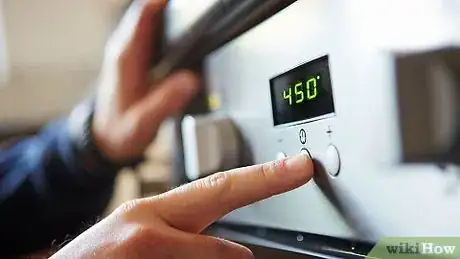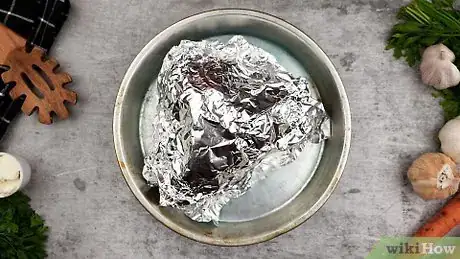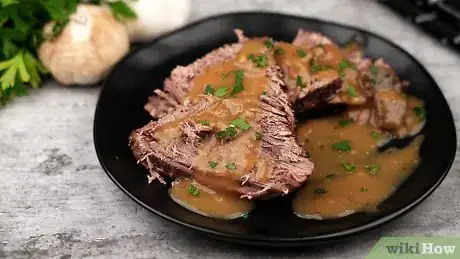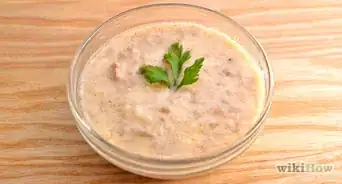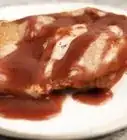This article was co-authored by Ollie George Cigliano. Ollie George Cigliano is a Private Chef, Food Educator, and Owner of Ollie George Cooks, based in Long Beach, California. With over 20 years of experience, she specializes in utilizing fresh, fun ingredients and mixing traditional and innovative cooking techniques. Ollie George holds a BA in Comparative Literature from The University of California, Berkeley, and a Nutrition and Healthy Living Certificate from eCornell University.
This article has been viewed 68,133 times.
Roast beef gravy is a delicious, savory dish that adds flavor and substance to any home-cooked meal. It’s not only very versatile, but is also an impressive dish that almost anyone can learn how to cook. All you have to do is collect some juices from roasting beef, then cook them with flour, beef stock, and seasoning.
Ingredients
- 5 lb (2.3 kg) boneless rump roast
- 4 tablespoons (35 grams) of flour
- 2 cups (470 mL) of beef stock
- 1 tablespoon (17 grams) of salt (optional)
- 1 tablespoon (17 grams) of pepper (optional)
- 1⁄4 cup (59 mL) of vinegar (optional)
- 5-6 onion slices (optional)
Yields 4 servings
Steps
Roasting the Beef
-
1Preheat your oven to 450 °F (232 °C). It should take 10-15 minutes for your oven to heat to this temperature. This would be a good time to take your roast out of the refrigerator and gather any other materials you may need.[1]
-
2Line a roasting pan with aluminum foil and place the roast inside it. For best results, use a 9 × 13 × 2 in (22.9 × 33.0 × 5.1 cm) roasting pan, heavy duty aluminum foil, and a 5 lb (2.3 kg) boneless roast. Place the roast in the center of the pan to make it easier to wrap it in the foil later on.[2]
- Be sure to place enough foil in the pan to not only cover the pan, but also be able to wrap the entire roast in foil as well.
- If you’d like to season your roast before cooking it, you can also sprinkle 1 tablespoon (17 grams) of salt, 1 tablespoon (17 grams) of pepper, and 1⁄4 cup (59 mL) of vinegar over it. For even more flavoring, lay 5-6 onion slices over top of it.
Advertisement -
3Wrap the roast in the aluminum foil and cook it in the oven for 3-4 hours. Pull the extra foil up from the sides of the roasting pan to wrap the roast. Bake the roast until the meat is tender and brown, which should take about 3-4 hours. Use a fork to check if the meat is tender after 3 hours.[3]
- You can also use the internal temperature of the roast to determine when it’s done. Use a thermometer to check the temperature; once it reaches 130 °F (54 °C), it’s safe to take the roast out of the oven.
-
4Remove the roast from the oven and let it cool for around 20 minutes. Be sure to use heat-resistant oven mitts to take the pan out of the oven. Leave the roast inside the pan to allow the roast juices to seep out of it.[4]
- These juices are what you’ll use to make your gravy, so it’s very important that you give them enough time to seep out of the roast.
-
5Transfer the roast to a separate dish, leaving the juices in the pan. Unwrap the aluminum foil covering the roast very carefully in order to preserve all the juices that seeped out. If you plan to slice the roast immediately, go ahead and put it on a large cutting board.[5]
- If you don’t plan to cut the roast right away, put it in a dish or pan that will catch any additional juices that continue to seep out of it, such as another roasting pan or a deep saucepan.
Using the Roast Juices to Make the Gravy
-
1Remove all but 1⁄4 cup (59 mL) of fat from the roasting pan. You want there to be some fat in the pan to cook the gravy in, but not so much that it ruins the finished product. An easy way to remove the fat is to slightly tilt the pan so that you can clearly see the fat separate from the darker juices. Then, use a small spoon to scoop out most of the fat.[6]
- The fat in the pan will be white and relatively thick as compared to the rest of the juices.
- If you’d rather not eyeball it, you can also opt to remove all of the fat from the pan, then measure out 1⁄4 cup (59 mL) to pour back into the pan.
-
2Use a wooden spoon to loosen any drippings on the pan. These are the dark, crusty bits on the bottom and sides of the pan. The drippings are where all the flavor is, so this is a very important step.[7]
- You don’t need to do anything else to the drippings; you just want them to not be stuck to the pan when you’re cooking the gravy.
-
3Place the pan over medium heat and allow the fat to start to sizzle. This shouldn’t take more than 3-5 minutes. Medium heat is the middle setting on your stovetop dial.[8]
- For example, if the dial on your stovetop runs from 1 to 10, turn it to 5 to set your stove to medium heat.
-
4Add 4 tablespoons (35 grams) of flour to the mixture while whisking it. Stir quickly with an iron whisk as you pour in the flour so that it fully incorporates with the fat in the pan. Continue whisking the flour until it forms a thick paste and is slightly brown.[9]
- For best results, pour the flour into the pan 1 tablespoon (9 grams) at a time.
-
5Pour 2 cups (470 mL) of beef stock into the pan and whisk. Once the flour paste has formed in the pan, slowly pour in the stock a little bit at a time. Make sure to continuously stir with your whisk as you pour in the stock, so that the flour paste becomes fully dissolved in the liquid.[10]
- It’s important to add the stock a little at a time, not only so that the ingredients more easily mix together, but also to avoid the stock splashing out of the pan.
-
6Bring the mixture to a boil and allow it to simmer for 4-5 minutes. It should only take a few minutes for the mixture to begin to boil. As it’s boiling, add water as necessary to either thin out the gravy or ensure you have enough.[11]
- Conversely, if the gravy is too watery for your tastes, you can also allow it to simmer for a little bit longer and let some of the excess water evaporate out.
-
7Season your gravy as needed and serve. It isn’t strictly necessary to add any seasoning to your gravy at this point, although many people prefer to season it with a bit of salt and pepper before serving it. Depending on your preferences, your gravy would probably only need about a pinch of each.[12]
- Other seasonings you might try with your gravy include oregano, rosemary, sage, thyme, and pepper.
-
8Store any leftover gravy in an airtight container in the refrigerator. The gravy won’t stay fresh for more than a couple of days, so try to use it as soon as possible. To reuse it, use a spoon to scrape off any fat that has risen to the surface, then heat it up in the microwave for about 30 seconds.[13]
- If you don’t think you’ll use your gravy anytime soon, you can also place it in the freezer for up to 4 months.
Community Q&A
-
QuestionHow long will it last in the fridge?
 Community AnswerUp to about four days, if sealed in an air-tight container. You could probably get five days out of it, but it really depends on the mixture. Stick your nose in. If it smells or looks bad, throw it out.
Community AnswerUp to about four days, if sealed in an air-tight container. You could probably get five days out of it, but it really depends on the mixture. Stick your nose in. If it smells or looks bad, throw it out.
Things You’ll Need
- Roasting pan
- Heavy duty aluminum foil
- Wooden spoon
References
- ↑ https://www.foodnetwork.com/recipes/trisha-yearwood/roast-beef-with-gravy-recipe-2109869
- ↑ https://www.foodnetwork.com/recipes/trisha-yearwood/roast-beef-with-gravy-recipe-2109869
- ↑ https://www.foodnetwork.com/recipes/trisha-yearwood/roast-beef-with-gravy-recipe-2109869
- ↑ https://www.countryliving.com/food-drinks/recipes/a1683/sunday-best-roast-beef-pan-gravy-3798/
- ↑ https://www.foodnetwork.com/recipes/trisha-yearwood/roast-beef-with-gravy-recipe-2109869
- ↑ https://www.simplyrecipes.com/recipes/how_to_make_gravy/
- ↑ https://www.geniuskitchen.com/recipe/traditional-gravy-for-roast-beef-lamb-pork-or-duck-263755
- ↑ https://www.geniuskitchen.com/recipe/traditional-gravy-for-roast-beef-lamb-pork-or-duck-263755
- ↑ https://www.simplyrecipes.com/recipes/how_to_make_gravy/
- ↑ https://www.simplyrecipes.com/recipes/how_to_make_gravy/
- ↑ https://www.countryliving.com/food-drinks/recipes/a1683/sunday-best-roast-beef-pan-gravy-3798/
- ↑ https://www.countryliving.com/food-drinks/recipes/a1683/sunday-best-roast-beef-pan-gravy-3798/
- ↑ https://www.thekitchn.com/leftover-gravy-tips-from-the-kitchn-213026
About This Article
To make a gravy for roast beef, start by removing most, but not all, of the fat from some roast beef drippings. Then, use a wooden spoon to loosen any drippings stuck to the pan, and heat the drippings over medium heat until they start to sizzle. Next, whisk 4 tablespoons of flour and 2 cups of beef stock into the mixture until the flour is completely dissolved. Finally, simmer the mixture for 4-5 minutes. To learn how to make roast beef, keep reading!
